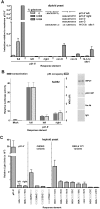Noncanonical DNA motifs as transactivation targets by wild type and mutant p53
- PMID: 18714371
- PMCID: PMC2518093
- DOI: 10.1371/journal.pgen.1000104
Noncanonical DNA motifs as transactivation targets by wild type and mutant p53
Erratum in
- PLoS Genet. 2008 Jul;4(7). doi: 10.1371/annotation/13bc83be-2345-401d-b953-f1886e9fbdff. Nourredine, Maher [corrected to Noureddine, Maher]; Bell, Douglas [corrected to Bell, Douglas A] doi: 10.1371/annotation/13bc83be-2345-401d-b953-f1886e9fbdff
- PLoS Genet. 2008 Nov;4(11).doi.org/10.1371/annotation/f7fc9c28-14ae-480d-a69e-ee9cc4fba9a7
Abstract
Sequence-specific binding by the human p53 master regulator is critical to its tumor suppressor activity in response to environmental stresses. p53 binds as a tetramer to two decameric half-sites separated by 0-13 nucleotides (nt), originally defined by the consensus RRRCWWGYYY (n = 0-13) RRRCWWGYYY. To better understand the role of sequence, organization, and level of p53 on transactivation at target response elements (REs) by wild type (WT) and mutant p53, we deconstructed the functional p53 canonical consensus sequence using budding yeast and human cell systems. Contrary to early reports on binding in vitro, small increases in distance between decamer half-sites greatly reduces p53 transactivation, as demonstrated for the natural TIGER RE. This was confirmed with human cell extracts using a newly developed, semi-in vitro microsphere binding assay. These results contrast with the synergistic increase in transactivation from a pair of weak, full-site REs in the MDM2 promoter that are separated by an evolutionary conserved 17 bp spacer. Surprisingly, there can be substantial transactivation at noncanonical (1/2)-(a single decamer) and (3/4)-sites, some of which were originally classified as biologically relevant canonical consensus sequences including PIDD and Apaf-1. p53 family members p63 and p73 yielded similar results. Efficient transactivation from noncanonical elements requires tetrameric p53, and the presence of the carboxy terminal, non-specific DNA binding domain enhanced transactivation from noncanonical sequences. Our findings demonstrate that RE sequence, organization, and level of p53 can strongly impact p53-mediated transactivation, thereby changing the view of what constitutes a functional p53 target. Importantly, inclusion of (1/2)- and (3/4)-site REs greatly expands the p53 master regulatory network.
Conflict of interest statement
The authors have declared that no competing interests exist.
Figures





References
-
- Ko LJ, Prives C. p53: puzzle and paradigm. Genes Dev. 1996;10:1054–1072. - PubMed
-
- Levine AJ. p53, the cellular gatekeeper for growth and division. Cell. 1997;88:323–331. - PubMed
-
- Menendez D, Inga A, Jordan JJ, Resnick MA. Changing the p53 master regulatory network: ELEMENTary, my dear Mr Watson. Oncogene. 2007;26:2191–2201. - PubMed
-
- Raver-Shapira N, Marciano E, Meiri E, Spector Y, Rosenfeld N, et al. Transcriptional activation of miR-34a contributes to p53-mediated apoptosis. Mol Cell. 2007;26:731–743. - PubMed
MeSH terms
Substances
LinkOut - more resources
Full Text Sources
Other Literature Sources
Research Materials
Miscellaneous

